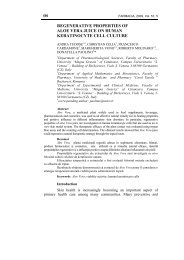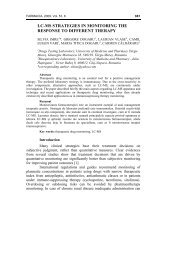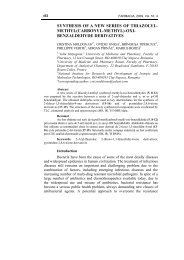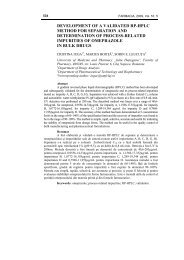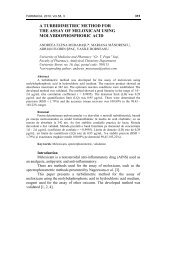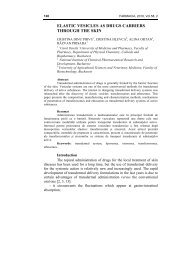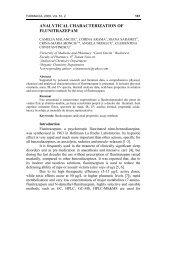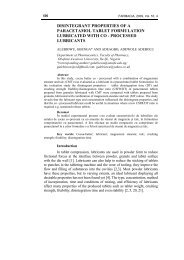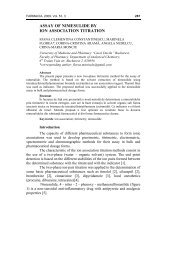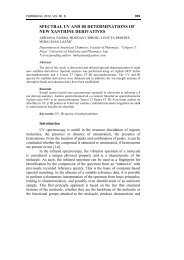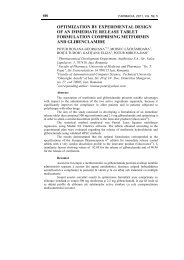Determination of cocaine and benzoylecgonine in - revista farmacia
Determination of cocaine and benzoylecgonine in - revista farmacia
Determination of cocaine and benzoylecgonine in - revista farmacia
Create successful ePaper yourself
Turn your PDF publications into a flip-book with our unique Google optimized e-Paper software.
FARMACIA, 2009, Vol. 57, 3<br />
DETERMINATION OF COCAINE AND<br />
BENZOYLECGONINE IN HUMAN PLASMA BY<br />
LC-MS/MS<br />
DANIELA-SAVETA POPA, LAURIAN VLASE, SORIN E.<br />
LEUCUŢA, FELICIA LOGHIN<br />
301<br />
University <strong>of</strong> Medic<strong>in</strong>e <strong>and</strong> Pharmacy „Iuliu Haţieganu”, Faculty <strong>of</strong><br />
Pharmacy, 13 Emil Isac, Cluj-Napoca - 400023, Romania<br />
*correspond<strong>in</strong>g author: dpopa@umfcluj.ro<br />
Abstract<br />
A high-throughput Liquid chromatography/ Mass spectrometry/ Mass<br />
spectrometry (LC/MS/MS) method for simultaneous quantification <strong>of</strong> <strong>coca<strong>in</strong>e</strong> (COC) <strong>and</strong><br />
<strong>benzoylecgon<strong>in</strong>e</strong> (BZE) <strong>in</strong> human plasma was elaborated. After the prote<strong>in</strong> precipitation<br />
with methanol <strong>in</strong> the plasma samples, the analytes were separated on a Zorbax SB-C18<br />
column under isocratic conditions us<strong>in</strong>g a 32:68 (v/v) mixture <strong>of</strong> methanol <strong>and</strong> 0.1% formic<br />
acid <strong>in</strong> water at 45ºC, with a flow rate <strong>of</strong> 1 mL/m<strong>in</strong>. The detection was <strong>in</strong> multiple reaction<br />
monitor<strong>in</strong>g (MRM) mode (m/z 290 → m/z 168 for BZE <strong>and</strong> m/z 304 → m/z 182 for COC,<br />
respectively). Calibration curves were generated over the range <strong>of</strong> 20-2000 ng/mL for both<br />
BZE <strong>and</strong> COC (r > 0.992). In the laboratories that are not equipped with a LC/MS/MS<br />
system, the LC analysis <strong>of</strong> COC <strong>and</strong> BZE requires a previous isolation step. Therefore, the<br />
elaborated LC/MS/MS method was applied for the study <strong>of</strong> optimum experimental<br />
conditions for the isolation <strong>of</strong> COC <strong>and</strong> BZE from human plasma. Several solvent mixtures<br />
<strong>and</strong> solid-phase extraction (SPE) cartridges were tested at different pH values. The best<br />
results for both analytes were obta<strong>in</strong>ed by SPE on Oasis HLB cartridges (mean recovery <strong>of</strong><br />
71 % for COC <strong>and</strong> 92.4 % for BZE, n = 3). Both the elaborated LC/MS/MS method <strong>and</strong> the<br />
best extraction conditions can successfully be applied <strong>in</strong> cl<strong>in</strong>ical <strong>and</strong> forensic toxicology for<br />
the rapid quantification <strong>of</strong> COC <strong>and</strong> BZE <strong>in</strong> human plasma.<br />
Rezumat<br />
S-a elaborat o metodă rapidă LC/MS/MS pentru cuantificarea simultană a<br />
<strong>coca<strong>in</strong>e</strong>i (COC) şi benzoilecgon<strong>in</strong>ei (BZE) d<strong>in</strong> plasma umană. După precipitarea<br />
prote<strong>in</strong>elor cu metanol în probele de plasmă, analiţii s-au separat pe o coloană Zorbax SB-<br />
C18 în condiţii izocratice folos<strong>in</strong>d un amestec 32:68 (v/v) de metanol şi soluţie apoasă de<br />
acid formic 0,1%, la 45ºC cu un debit de 1 mL/m<strong>in</strong>. Detecţia s-a realizat în modul MRM<br />
(monitorizarea reacţiilor multiple) (m/z 290 → m/z 168 pentru BZE, respectiv m/z 304 →<br />
m/z 182 pentru COC). Curbele de calibrare s-au realizat pe domeniul de concentraţii 20-<br />
2000 ng/mL atât pentru BZE cât şi pentru COC (r > 0.992). În laboratoarele care nu sunt<br />
echipate cu un sistem LC/MS/MS, analiza LC a COC şi BZE necesită anterior o etapă de<br />
izolare. Astfel, metoda LC/MS/MS elaborată s-a aplicat în studiul condiţiilor experimentale<br />
optime necesare izolării COC şi BZE d<strong>in</strong> plasma umană. S-au testat mai multe amestecuri<br />
de solvenţi şi cartuşe de extracţie pe fază solidă (EFS) la diferite valori de pH. Cele mai<br />
bune rezultate s-au obţ<strong>in</strong>ut pr<strong>in</strong> EFS cu cartuşe Oasis HLB (regăsiri medii de 71 % pentru<br />
COC şi 92.4 % pentru BZE). Atât metoda LC/MS/MS elaborată cât şi cele mai bune<br />
metode de extracţie evidenţiate se pot aplica cu succes în toxicología cl<strong>in</strong>ică şi medicolegală<br />
în vederea dozării rapide a COC şi BZE d<strong>in</strong> plasma umană.
302<br />
FARMACIA, 2009, Vol. 57, 3<br />
Keywords: <strong>coca<strong>in</strong>e</strong>, <strong>benzoylecgon<strong>in</strong>e</strong>, human plasma, LC-MS/MS<br />
Introduction<br />
Coca<strong>in</strong>e (COC) abuse has <strong>in</strong>creased dramatically dur<strong>in</strong>g the past<br />
three decades. Benzoylecgon<strong>in</strong>e (BZE) is the ma<strong>in</strong> <strong>coca<strong>in</strong>e</strong> metabolite,<br />
formed either by a hepatic carboxylesterase or by spontaneous hydrolysis<br />
[6]. Several LC/MS/MS applications for COC have been published, but they<br />
have been either qualitative analysis <strong>in</strong> plasma [11] or quantitative analysis<br />
<strong>of</strong> COC <strong>and</strong> its metabolites <strong>in</strong> other matrices such as ur<strong>in</strong>e [4], oral fluid [1],<br />
hair [7, 8] <strong>and</strong> meconium [13]. Generally, the quantitative analysis <strong>of</strong> COC<br />
<strong>and</strong> BZE are performed by GC-MS, which requires derivatisation <strong>of</strong> BZE<br />
due to its polar nature [2, 3]. A new sensitive <strong>and</strong> selective LC/MS/MS<br />
method for the quantification <strong>of</strong> COC <strong>and</strong> BZE <strong>in</strong> human plasma was<br />
elaborated.<br />
In the laboratories that are not equipped with a LC/MS/MS system,<br />
the liquid chromatographic analysis <strong>of</strong> COC <strong>and</strong> BZE requires a previous<br />
isolation step [5, 12]. Therefore, the elaborated LC/MS/MS method was<br />
applied for the study <strong>of</strong> optimum experimental conditions for the isolation<br />
<strong>of</strong> COC <strong>and</strong> BZE from human plasma by liquid-liquid extraction (LLE) <strong>and</strong><br />
solid-phase extraction (SPE).<br />
Materials <strong>and</strong> methods<br />
Reagents <strong>and</strong> materials<br />
COC hydrochloride <strong>and</strong> BZE were st<strong>and</strong>ard references purchased<br />
from Lipomed AG (Arlesheim, Switzerl<strong>and</strong>). All chemicals were <strong>of</strong><br />
analytical-reagent grade. HPLC-grade methanol <strong>and</strong> 98% formic acid were<br />
purchased from Merck (Darmstadt, Germany), concentrated ammonia from<br />
Fluka (Buchs, Switzerl<strong>and</strong>), ethyl acetate, hexane, dichloromethane,<br />
isopropanol, disodium phosphate <strong>and</strong> monopotassium phosphate from<br />
Sigma-Aldrich (Ste<strong>in</strong>heim, Germany) <strong>and</strong> Tris hydrochloride from Riedel<br />
de Haën (Germany). Bidistilled, deionised water pro <strong>in</strong>jectiones was<br />
purchased from Infusion Solution Laboratory <strong>of</strong> University <strong>of</strong> Medic<strong>in</strong>e <strong>and</strong><br />
Pharmacy Cluj-Napoca, Romania. The human blank plasma was supplied<br />
by the Local Bleed<strong>in</strong>g Centre Cluj-Napoca, Romania. For SPE the<br />
follow<strong>in</strong>g cartridge types were used: Oasis ® MCX, 30 mg <strong>and</strong> Oasis ® HLB,<br />
30 mg (Waters Corporation, Massachusetts, Irel<strong>and</strong>), Isolute ® HCX, 130<br />
mg (International Sorbent Technology, Mid Glamorgan, UK), Chroma-bond<br />
C18ec (Macherey-Nagel, Düren, Germany) <strong>and</strong> SepPak C18, 300 mg (Lida<br />
Manufactur<strong>in</strong>g Corporation, Kenosha, WI, USA).
FARMACIA, 2009, Vol. 57, 3<br />
Apparatus<br />
The follow<strong>in</strong>g apparatus were used <strong>in</strong> this study: 204 Sigma<br />
Centrifuge (Osterode am Harz, Germany); Analytical Plus Balance (Mettler-<br />
Toledo, Switzerl<strong>and</strong>) <strong>and</strong> Discovery Balance (Ohaus, P<strong>in</strong>e Brook, NJ,<br />
SUA); Vortex Genie 2 (Scientific Industries, New York, USA); ultrasonic<br />
bath Elma Transsonic 700/H (S<strong>in</strong>gen, Germany); SPE automated extractor<br />
Chromabond ® Vacuum manifolds (Macherey-Nagel, Düren, Germany);<br />
evaporator with nitrogen stream (Cole-Parmer, USA).<br />
The HPLC system was a 1100 series model (Agilent Technologies,<br />
Darmstadt, Germany) consist<strong>in</strong>g <strong>of</strong> a G1312A b<strong>in</strong>ary pump, an <strong>in</strong>-l<strong>in</strong>e<br />
G1379A degasser, a G1329A autosampler, a G1316A column thermostat<br />
<strong>and</strong> an Agilent Ion Trap Detector (1100 VL; Agilent Technologies).<br />
Chromatographic separation was performed at 45ºC on a Zorbax<br />
SB-C18 (100 mm x 3.0 mm, 3.5 μm I.D) column (Agilent Technologies)<br />
protected by an <strong>in</strong>-l<strong>in</strong>e filter under isocratic conditions. The mobile phase<br />
was a 32:68 (v/v) mixture <strong>of</strong> methanol <strong>and</strong> 0.1% formic acid <strong>in</strong> water. The<br />
flow rate <strong>of</strong> the mobile phase was 1 mL/m<strong>in</strong>.<br />
Chromatograms were processed us<strong>in</strong>g Quant Analysis s<strong>of</strong>tware.<br />
The detection <strong>of</strong> BZE <strong>and</strong> COC was <strong>in</strong> the multiple-reaction<br />
monitor<strong>in</strong>g (MRM) mode us<strong>in</strong>g an ion trap mass spectrometer equipped<br />
with an atmospheric pressure chemical ionization ion source, <strong>in</strong> positive<br />
mode. The ion transitions monitored were m/z 290→ m/z 168 for BZE <strong>and</strong><br />
m/z 304→ m/z 182 for COC, respectively.<br />
St<strong>and</strong>ard solutions<br />
1 mg/mL stock solutions <strong>of</strong> COC <strong>and</strong> BZE were prepared by<br />
dissolv<strong>in</strong>g the appropriate quantities <strong>of</strong> reference substances <strong>in</strong> 5 mL<br />
methanol. The marked plasma samples with the concentrations <strong>of</strong> 300 <strong>and</strong><br />
1000 ng/mL were obta<strong>in</strong>ed by dilut<strong>in</strong>g specific volumes <strong>of</strong> COC <strong>and</strong> BZE<br />
stock solutions, respectively, with blank plasma.<br />
Sample preparation<br />
All analysis were performed <strong>in</strong> triplicate.<br />
For LLE, spiked plasma samples (0.5 mL) were mixed with 2.5 mL<br />
buffer solution (0.1 M phosphate buffer pH 6 or 0.1 M Tris buffer pH 8.4)<br />
<strong>and</strong> 5 mL organic solvent (Table I) at vortex-mixer for 5 m<strong>in</strong>utes. After<br />
centrifugation, the organic phase was separated <strong>and</strong> evaporated to dryness at<br />
50ºC under a nitrogen stream. The dry extract was reconstituted <strong>in</strong> 500 μL<br />
<strong>of</strong> water:methanol 80:20 (v/v) <strong>and</strong> a 4 μL aliquot was <strong>in</strong>jected <strong>in</strong>to the<br />
chromatograph.<br />
For SPE, spiked plasma samples (0.5 mL) were mixed with 2.5mL<br />
0.1 M phosphate buffer (pH 6) at vortex-mixer for 30 seconds, than<br />
303
304<br />
FARMACIA, 2009, Vol. 57, 3<br />
centrifugated. The tested cartridges were successively conditioned with<br />
methanol, bidistillated water <strong>and</strong> 0.1 M phosphate buffer (pH 6). After<br />
sample supernatant addition, the cartridges were washed with 0.001 M<br />
phosphate buffer (pH 6). The volumes <strong>of</strong> the solutions used for condition<strong>in</strong>g<br />
<strong>and</strong> wash<strong>in</strong>g were 3 mL for Oasis MCX, Oasis HLB <strong>and</strong> Isolute HCX, <strong>and</strong> 5<br />
mL for Chroma-bond C18ec <strong>and</strong> SepPak C18, respectively. The elution was<br />
performed <strong>in</strong> two consecutive phases, with: a) methanol : conc. ammonia<br />
(19:1, v/v) (2 mL) <strong>and</strong> b) dichlormethane : isopropanol (9:1, v/v) (2 mL).<br />
Each eluate was evaporated to dryness at 45ºC under a nitrogen stream. The<br />
dry extract was reconstituted <strong>in</strong> 500 μL water:methanol 80:20 (v/v) <strong>and</strong> a 4<br />
μL aliquot was <strong>in</strong>jected <strong>in</strong>to the chromatograph.<br />
Results <strong>and</strong> discussion<br />
We propose a very simple <strong>and</strong> rapid pretreatment <strong>of</strong> plasma<br />
samples <strong>in</strong>clud<strong>in</strong>g only prote<strong>in</strong> precipitation by methanol <strong>and</strong> direct<br />
<strong>in</strong>jection <strong>in</strong>to the chromatographic system <strong>of</strong> the supernatant obta<strong>in</strong>ed after<br />
centrifugation.<br />
The chromatographic conditions, especially the composition <strong>of</strong> the<br />
mobile phase, were optimized <strong>in</strong> several trials <strong>in</strong> order to achieve a good<br />
MS signal, a short retention time for COC <strong>and</strong> BZE with an adequate<br />
separation <strong>and</strong> consequently a high-throughput analysis. The best results<br />
were obta<strong>in</strong>ed with the mixture <strong>of</strong> methanol <strong>and</strong> 0.1% formic acid <strong>in</strong> water<br />
32:68 (v/v) under isocratic conditions at 45ºC, with a flow rate <strong>of</strong> 1mL/m<strong>in</strong>.<br />
In the selected chromatographic conditions the retention times <strong>of</strong> COC <strong>and</strong><br />
BZE were 1.35 m<strong>in</strong> <strong>and</strong> 1.15 m<strong>in</strong>, respectively, <strong>and</strong> the analytical run-time<br />
was 1.7 m<strong>in</strong>. Representative chromatograms <strong>of</strong> drug-free plasma <strong>and</strong> plasma<br />
spiked with COC <strong>and</strong> BZE at low limit <strong>of</strong> quantification (LLOQ) are shown<br />
<strong>in</strong> Fig. 1 <strong>and</strong> Fig. 2, respectively. No <strong>in</strong>terfer<strong>in</strong>g peaks from the endogenous<br />
plasma components were observed at the retention times <strong>of</strong> COC <strong>and</strong> BZE.<br />
The calibration curves were l<strong>in</strong>ear over the concentration range <strong>of</strong> 20-2000<br />
ng/mL <strong>in</strong> human plasma, with a correlation coefficient greater than 0.992.<br />
The LLOQ was 20 ng/mL.<br />
The values for the recovery obta<strong>in</strong>ed after LLE <strong>and</strong> SPE extractions<br />
<strong>of</strong> COC <strong>and</strong> BZE from human plasma are presented <strong>in</strong> Tables I <strong>and</strong> II,<br />
respectively. COC <strong>and</strong> BZE are the hydrophylic basic compounds with pKa<br />
> 8, but BZE is more polar (log Po/w <strong>of</strong> -1.3) than COC (log Po/w <strong>of</strong> 2.3) [10]<br />
<strong>and</strong> cannot be efficiently isolated by LLE [9].
FARMACIA, 2009, Vol. 57, 3<br />
Intens.<br />
x104<br />
2.0<br />
1.5<br />
1.0<br />
0.5<br />
0.0<br />
x104<br />
2.0<br />
1.5<br />
1.0<br />
0.5<br />
0.0<br />
Intens.<br />
x104<br />
2.5<br />
2.0<br />
1.5<br />
1.0<br />
0.5<br />
0.0<br />
x104<br />
1.5<br />
1.0<br />
0.5<br />
0.0<br />
cal1__01.D: EIC 168 ±MS2(290), Smoothed (0.5,1, GA)<br />
cal1__01.D: EIC 182 ±MS2(304), Smoothed (0.5,1, GA)<br />
0.2 0.4 0.6 0.8 1.0 1.2 1.4 Time [m<strong>in</strong>]<br />
Figure 1<br />
Chromatogram <strong>of</strong> plasma blank<br />
cal1__04.D: EIC 168 ±MS2(290), Smoothed (0.5,1, GA)<br />
1<br />
cal1__04.D: EIC 182 ±MS2(304), Smoothed (0.5,1, GA)<br />
0.2 0.4 0.6 0.8 1.0 1.2 1.4 Time [m<strong>in</strong>]<br />
Figure 2<br />
Chromatograms <strong>of</strong> plasma spiked with COC (1) <strong>and</strong> BZE (2)<br />
at LLOQ level (20 ng/mL)<br />
Besides the higher polarity <strong>of</strong> BZE, its LC/MS signal may be also<br />
suppressed by endogenous <strong>in</strong>terferents from alkal<strong>in</strong>e extracts, so the<br />
apparent calculated recovery can be consequently lowered [14, 15]. The<br />
2<br />
305
306<br />
FARMACIA, 2009, Vol. 57, 3<br />
recoveries obta<strong>in</strong>ed with the tested solvents were poor (< 7.3%), except the<br />
extraction <strong>in</strong> dichloromethane at pH 6, that was better but <strong>in</strong>sufficient<br />
(~16%) (Table I).<br />
The SPE extraction from plasma was performed at pH 6. Both<br />
analytes were eluted with the first eluent (Table II). The concentrations <strong>of</strong><br />
COC <strong>and</strong> BZE were <strong>in</strong>significant <strong>in</strong> the second eluent. The best results for<br />
both analytes were obta<strong>in</strong>ed with Oasis HLB cartridges (68.57% recovery<br />
for COC <strong>and</strong> 91.85% for BZE at 300 ng/mL, <strong>and</strong> 73.47% for COC <strong>and</strong><br />
92.96% for BZE at 1000 ng/mL, respectively, n = 3).<br />
Table I<br />
Recovery <strong>of</strong> <strong>coca<strong>in</strong>e</strong> <strong>and</strong> <strong>benzoylecgon<strong>in</strong>e</strong> from human plasma by LLE us<strong>in</strong>g different<br />
solvent mixtures at different plasma pH (n=3)<br />
Nom<strong>in</strong>al C COC BZE<br />
Solvent mixture pH ng/mL Recovery CV % Recovery CV %<br />
%<br />
%<br />
CH2Cl2 6 300 66.65 9.70 17.18 1.19<br />
1000 63.57 3.15 15.01 1.76<br />
Ethyl acetate 6 300 54.27 1.47 1.94 1.68<br />
1000 69.50 1.88 1.21 0.43<br />
CH2Cl2:IP 300 57.04 3.81 2.74 2.41<br />
* :hexane 6<br />
(5:1:1, v/v)<br />
1000 64.54 10.03 3.14 0.56<br />
CH2Cl2:IP:ethyl 8.4 300 57.84 3.64 5.00 0.97<br />
acetate (5:1:1, v/v)<br />
1000 65.47 2.98 4.86 0.31<br />
CH2Cl2:IP:hexane 8.4 300 41.59 6.31 5.24 0.21<br />
(5:1:1, v/v)<br />
*<br />
IP = isopropanol<br />
1000 57.43 18.40 7.27 2.19<br />
Table II<br />
Recovery <strong>of</strong> <strong>coca<strong>in</strong>e</strong> <strong>and</strong> <strong>benzoylecgon<strong>in</strong>e</strong> from human plasma by SPE us<strong>in</strong>g different<br />
cartridges at pH 6 (n=3) <strong>in</strong> the first eluent, methanol:ammonia conc. (19:1, v/v)<br />
SPE Nom<strong>in</strong>al C<br />
COC BZE<br />
cartridge ng/mL Recovery % CV % Recovery % CV %<br />
Chroma-bond 300 56.03 3.21 80.38 6.61<br />
C18 ec 1000 71.71 6.30 95.42 3.85<br />
SepPak C18 300 61.78 1.11 82.38 2.82<br />
1000 68.41 6.00 85.63 6.04<br />
Izolute 300 60.38 14.37 84.68 2.47<br />
1000 78.28 2.87 89.34 6.68<br />
Oasis MCX 300 60.08 2.70 91.66 8.93<br />
1000 67.74 8.04 90.25 11.64<br />
Oasis HLB 300 68.57 9.96 91.85 4.78<br />
1000 73.47 9.99 92.96 12.45
FARMACIA, 2009, Vol. 57, 3<br />
Conclusions<br />
The elaborated LC/MS/MS method can be useful for the rapid<br />
quantification <strong>of</strong> COC <strong>and</strong> its metabolite <strong>in</strong> human plasma <strong>in</strong> different<br />
toxicological studies.<br />
The best results for the isolation <strong>of</strong> both analytes from human<br />
plasma were obta<strong>in</strong>ed by solid-phase extraction with Oasis HLB cartridges.<br />
These optimum experimental conditions for the isolation <strong>of</strong> COC <strong>and</strong> BZE<br />
from plasma samples can be used <strong>in</strong> other classical HPLC determ<strong>in</strong>ations <strong>of</strong><br />
these analytes.<br />
References<br />
1. Concheiro M, de Castro A, Qu<strong>in</strong>tela O, Cruz A, López-Rivadulla M.<br />
<strong>Determ<strong>in</strong>ation</strong> <strong>of</strong> illicit <strong>and</strong> medic<strong>in</strong>al drugs <strong>and</strong> their metabolites <strong>in</strong> oral fluid <strong>and</strong><br />
preserved oral fluid by liquid chromatography-t<strong>and</strong>em mass spectrometry. Anal<br />
Bioanal Chem. 2008; 391(6): 2329-2338<br />
2. Da Matta Chas<strong>in</strong> AA, Midio AF. Validation <strong>of</strong> an ion-trap gas chromatographicmass<br />
spectrometric method for the determ<strong>in</strong>ation <strong>of</strong> <strong>coca<strong>in</strong>e</strong> <strong>and</strong> metabolites <strong>and</strong><br />
cocaethylene <strong>in</strong> post mortem whole blood. Forensic Sci Int. 2000; 109: 1-13<br />
3. De Toledo FC, Yonam<strong>in</strong>e M, de Moraes Moreau RL, Silva OA. <strong>Determ<strong>in</strong>ation</strong> <strong>of</strong><br />
<strong>coca<strong>in</strong>e</strong>, <strong>benzoylecgon<strong>in</strong>e</strong> <strong>and</strong> cocaethylene <strong>in</strong> human hair by solid-phase<br />
microextraction <strong>and</strong> gas chromatography-mass spectrometry. J Chromatogr B.<br />
2003; 798(2): 361-365<br />
4. Feng J, Wang L, Dai I, Harmon T, Bernert JT. Simultaneous determ<strong>in</strong>ation <strong>of</strong><br />
multiple drugs <strong>of</strong> abuse <strong>and</strong> relevant metabolites <strong>in</strong> ur<strong>in</strong>e by LC-MS-MS. J Anal<br />
Toxicol. 2007; 31(7): 359-368<br />
5. Fernández P, Lago M, Lorenzo RA, Carro AM, Bermejo AM, Tabernero MJ.<br />
Microwave-assisted extraction <strong>and</strong> HPLC-DAD determ<strong>in</strong>ation <strong>of</strong> drugs <strong>of</strong> abuse<br />
<strong>in</strong> human plasma. J Anal Toxicol. 2007; 31(7): 388-393<br />
6. Flomenbaum NE, Goldfrank LR, H<strong>of</strong>fman RS, Howl<strong>and</strong> MA, Lew<strong>in</strong> NA, Nelson<br />
LS. Goldfrank’s Toxicologic Emergencies, McGraw-Hill, New York, 2006, 1135<br />
7. Hegstad S, Khiabani HZ, Krist<strong>of</strong>fersen L, Kunøe N, Lobmaier PP, Christophersen<br />
AS. Drug screen<strong>in</strong>g <strong>of</strong> hair by liquid chromatography-t<strong>and</strong>em mass spectrometry.<br />
J Anal Toxicol. 2008; 32(5): 364-372<br />
8. Hill V, Cairns T, Schaffer M. Hair analysis for <strong>coca<strong>in</strong>e</strong>: factors <strong>in</strong> laboratory<br />
contam<strong>in</strong>ation studies <strong>and</strong> their relevance to pr<strong>of</strong>iciency sample preparation <strong>and</strong><br />
hair test<strong>in</strong>g practices. Forensic Sci Int. 2008; 176(1): 23-33<br />
9. Johansen SS, Bhatia HM. Quantitative analysis <strong>of</strong> <strong>coca<strong>in</strong>e</strong> <strong>and</strong> its metabolites <strong>in</strong><br />
whole blood <strong>and</strong> ur<strong>in</strong>e by high-performance liquid chromatography coupled with<br />
t<strong>and</strong>em mass spectrometry. J Chromatogr B. 2007; 852(1-2): 338-344<br />
10. M<strong>of</strong>fat AC, Osselton MD, Widdop B, Clarke’s Analysis <strong>of</strong> Drugs <strong>and</strong> Poisons <strong>in</strong><br />
pharmaceuticals, body fluids <strong>and</strong> postmortem material, third ed., Pharmaceutical<br />
Press, London, 2004, 687-845<br />
11. Rook EJ, Hillebr<strong>and</strong> MJ, Ros<strong>in</strong>g H, van Ree JM, Beijnen JH. The quantitative<br />
analysis <strong>of</strong> hero<strong>in</strong>, methadone <strong>and</strong> their metabolites <strong>and</strong> the simultaneous<br />
detection <strong>of</strong> <strong>coca<strong>in</strong>e</strong>, acetylcode<strong>in</strong>e <strong>and</strong> their metabolites <strong>in</strong> human plasma by<br />
307
308<br />
FARMACIA, 2009, Vol. 57, 3<br />
high-performance liquid chromatography coupled with t<strong>and</strong>em mass<br />
spectrometry. J Chromatogr B. 2005; 824(1-2): 213-221<br />
12. Tagliaro F, Antonioli C, De Battisti Z, Ghielmi S, Marigo M. Reversed-phase<br />
high-performance liquid chromatographic determ<strong>in</strong>ation <strong>of</strong> <strong>coca<strong>in</strong>e</strong> <strong>in</strong> plasma <strong>and</strong><br />
human hair with direct fluorimetric detection. J Chromatogr A. 1994; 674(1-2):<br />
207-215<br />
13. Xia Y, Wang P, Bartlett MG, Solomon HM, Busch KL. An LC-MS-MS method<br />
for the comprehensive analysis <strong>of</strong> <strong>coca<strong>in</strong>e</strong> <strong>and</strong> <strong>coca<strong>in</strong>e</strong> metabolites <strong>in</strong> meconium.<br />
Anal Chem. 2000; 72(4): 764-771<br />
14. Popa DS, Kiss B, Vlase L, Muntean D, Logh<strong>in</strong> F. Methadone isolation from<br />
human plasma by liquid-liquid extraction <strong>and</strong> solid-phase extraction. Comparative<br />
study. Farmacia, 2008, 56(2): 115-121<br />
15. Anca Toiu, L. Vlase, Ilioara Oniga, M. Tămaş, LC-MS analysis <strong>of</strong> flavonoids<br />
from Viola tricolor L. (Violaceae), Farmacia, 2007, LV (5), 509- 515<br />
Manuscript received: 10.11.2008



